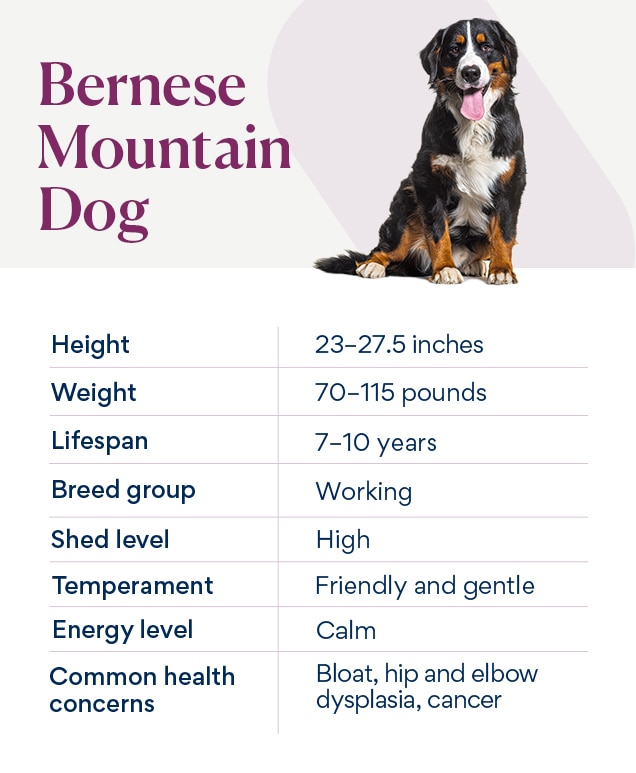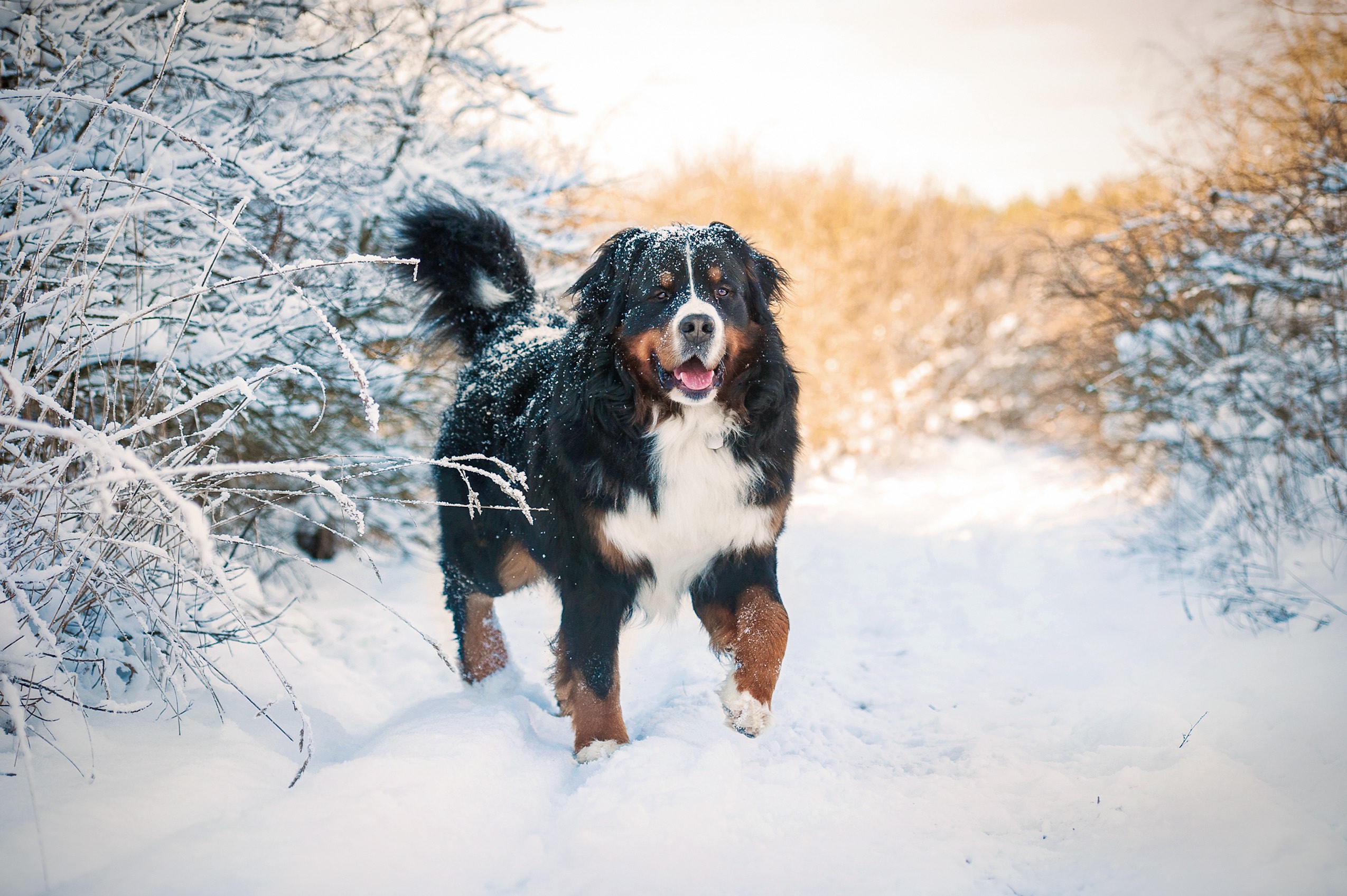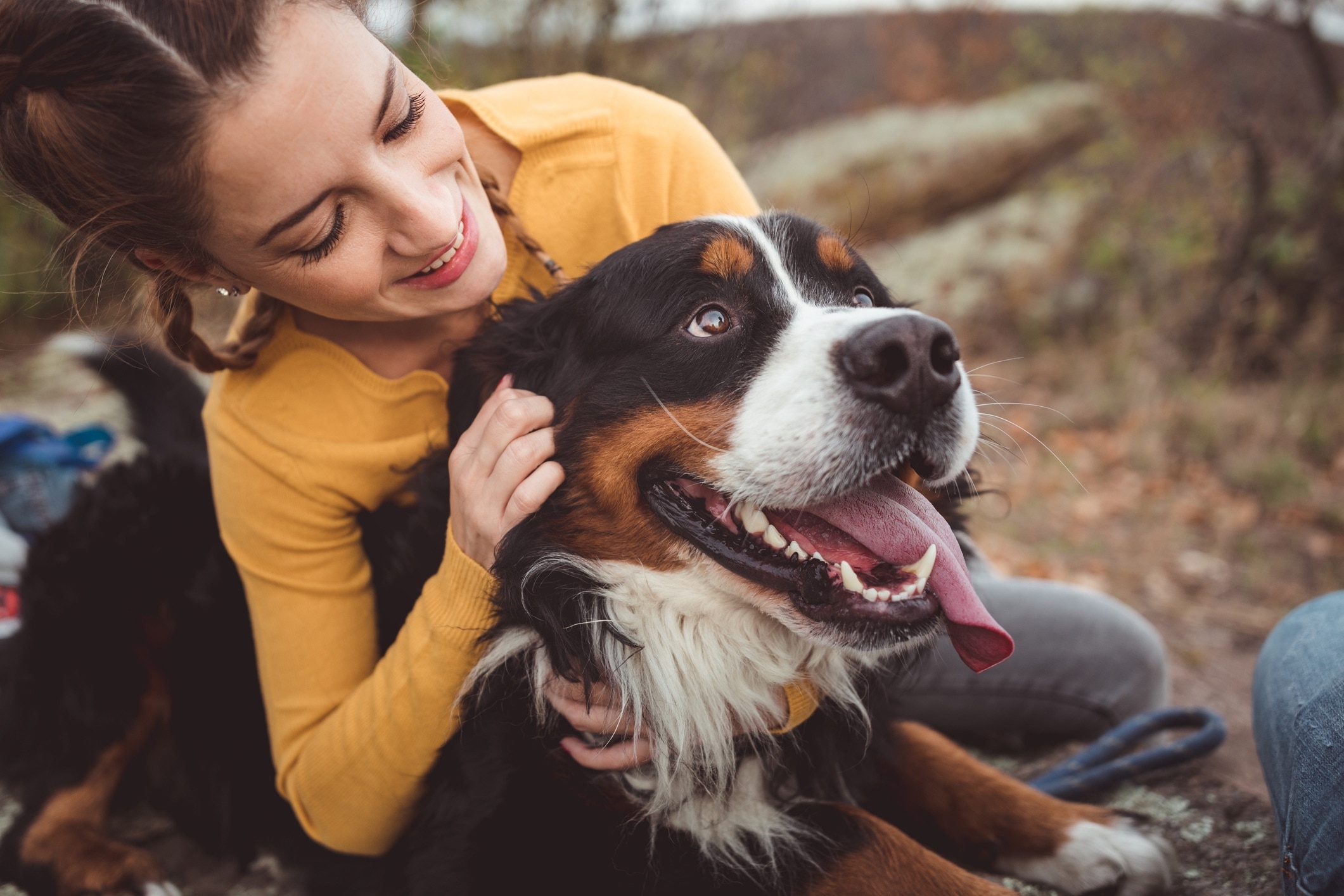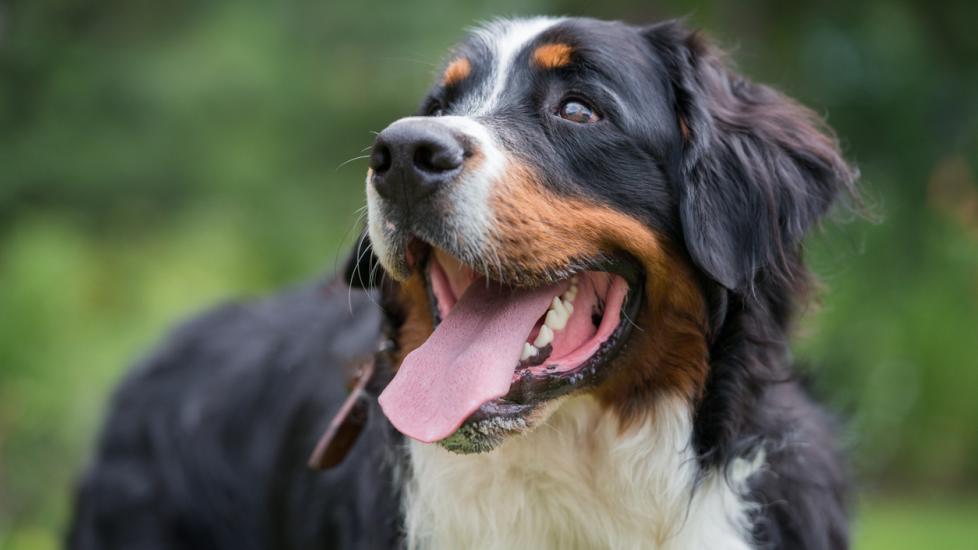Bernese Mountain Dog
iStock/K R E M
The big, beautiful Bernese Mountain Dog originated in Switzerland, where the breed was used as farm dogs. They were imported to the U.S. to work as farm dogs during the 1920s, but now these gentle giants are mostly family pets.
The first thing you’ll notice about these dogs is how big they are—the average Bernese Mountain Dog size is 23–27.5 inches tall and 70–115 pounds. But it doesn’t take long for the breed’s sweet temperament to become just as obvious; Bernese Mountain Dogs are super-sized pups that have a big heart to match.
Caring for Bernese Mountain Dogs

Berners (as the breed is often called) generally affectionate and patient with people and other pets. They are often calm dogs but can easily be enticed to play and need regular exercise to stay healthy.
Because of their thick double coat that comes in a tricolor black, white, and tan pattern, Bernese Mountain Dogs shed heavily year-round. They need a pet parent dedicated to grooming their fur—and one that doesn’t mind extra fur on the couch, floor, and clothing.
Bernese Mountain Dog Health Issues

The Bernese Mountain Dog lifespan is 7–10 years, which is about average for a large dog breed. They tend to be a healthy dog breed, but they can be predisposed to some health issues. Pet insurance may be a good investment for a family looking to bring home a Bernese Mountain Dog puppy.
Gastric Dilatation-Volvulus (GDV)
Gastric dilatation-volvulus (a severe form of bloat in dogs) is a condition that occurs suddenly and requires immediate life-saving intervention. This happens when the stomach fills up with food or gas, causing expansion and increased pressure.
The stomach can then rotate, which causes inadequate blood supply to the spleen and stomach. If not treated quickly, shock, tissue damage, and even death can occur. Increased risk is seen in:
-
Older dogs that have a deep chest (including the Bernese Mountain Dog)
-
Dogs that are fed from elevated bowls
-
Dogs that are fed only once per day
Immediate veterinary intervention is needed to stabilize and treat GDV. The longer a dog has this condition without intervention, the greater the risk of death.
To prevent GDV, a surgery called prophylactic gastropexy can secure the stomach to prevent it from twisting. This is often done at the same time as the dog’s spay or neuter surgery.
Hip Dysplasia
Hip dysplasia is when the hip joint doesn’t develop properly, causing a loose joint. This can be influenced by growth rate, hormones, diet, and/or exercise. Hip dysplasia can cause degenerative joint disease and osteoarthritis to develop. This arthritis leads to pain, limping, and difficulty standing.
Maintaining a lean body is important for preventing arthritis. Many vets recommend low-intensity exercise, omega-3 fatty acids (fish oil), and/or joint supplements containing glucosamine and chondroitin for dogs diagnosed with hip dysplasia. In severe cases, your vet might need to perform surgery.
Elbow Dysplasia
Elbow dysplasia is a condition where the elbow joint develops abnormally. This is usually influenced by genetics, abnormal/rapid growth, diet, and trauma.
The condition can cause pain, limping, and lameness, which can progress into arthritis. Treatment of elbow dysplasia varies based on the severity, but surgery is required in most cases.
Cancer
Bernese Mountain Dogs are prone to several types of cancer; one of the most common is called histiocytic sarcoma. There are three forms of histiocytic sarcoma:
-
Localized histiocytic sarcoma occurs as a localized tumor, often in the bones, skin, lungs, and joints.
-
Disseminated histiocytic sarcoma affects multiple areas at the same time.
-
Hemophagocytic histiocytic sarcoma starts in the spleen and spreads rapidly.
Signs of histiocytic sarcomas vary based on the location in the dog’s body, but many dogs will be lethargic, lose weight, and eat less. If your Bernese Mountain Dog’s weight is decreasing, take them to the vet.
Treatment varies case by case and can entail surgery, chemotherapy, and/or radiation.
What To Feed a Bernese Mountain Dog

Feeding commercial kibble or wet food that’s compliant with the Association of American Feed Control Officials (AAFCO)’s standards is a good way to make sure your Bernese Mountain Dog receives a complete and balanced diet.
As a giant breed, Bernese Mountain Dog puppies need to grow at a steady rate so their muscles and bone grow in unison. The bone and joints can become weak if their bones grow too quickly, and additional body weight places extra strain on these weak spots. Hip dysplasia and elbow dysplasia can also happen due to rapid growth.
To maintain a healthy growth rate in Bernese Mountain Dog puppies, proper amounts of fat, protein, and carbohydrates are necessary. Puppies can get all of their nutrition through AAFCO-compliant puppy foods designed for giant and large dogs. But as always, discuss with your veterinarian which puppy food is best for your individual dog.
How To Feed a Bernese Mountain Dog
Adult Bernese Mountain Dogs do best when they’re fed twice a day, about every 12 hours. Elevated bowls should be avoided, as these may increase the risk of gastric dilatation-volvulus or bloat. Instead, feed your Berner from a slow feeder bowl to slow them down and reduce the risk of GSV.
Bernese Mountain Dog puppies need to eat more frequently, up to four times every day. Talk to your veterinarian to determine the best feeding schedule.
How Much Should You Feed a Bernese Mountain Dog?
Just like with humans, the recommended caloric intake for Bernese Mountain Dogs varies between individuals—it all comes down to their size, metabolism, neuter/spay status, and activity level. Additionally, the caloric content for each food may vary drastically from one brand to the next.
The best way to determine how much to feed a Bernese Mountain Dog is to talk with your veterinarian. They can calculate how much you should feed your dog. Additionally, the feeding guide labels on your dog food provide valuable information about portions.
Nutritional Tips for Bernese Mountain Dogs
Bernese Mountain Dogs may benefit from omega-3 fatty acids (DHA/EPA) in their diet, at your veterinarian’s recommendation. Omega-3 fatty acids can be found in skin and joint supplements, fish oil, and even in some specially formulated dog foods. These fatty acids will act as natural anti-inflammatories that help to support the skin, coat, kidneys, joints, and heart.
Never give your dog a supplement, including omega-3, without speaking to your vet first.
Behavior and Training Tips for the Bernese Mountain Dog
Bernese Mountain Dog Personality and Temperament
In general, the Bernese Mountain Dog is an affectionate and intelligent dog. They are eager to please, which makes them good with training. They may be a little shy around people they don’t know, but the Bernese Mountain Dog tends to be patient with children and other pets.
That said, interactions between kids and dogs of all breeds should always be supervised. And while Bernese Mountain Dogs were bred as working farm dogs, today most prefer to lie on the couch all day.
Bernese Mountain Dog Behavior

The Bernese Mountain Dog is relatively adaptable to change and minor stressors, but these sweet pups may be shy in new settings. When properly socialized to dogs, cats, and people as puppies, a Berner is more adaptable and less likely to develop anxiety as an adult.
Many Bernese Mountain Dogs dislike being left alone, and some may develop separation anxiety.
Bernese Mountain Dog Training
The Bernese Mountain Dog is exceptionally intelligent and eager to please, making them a highly trainable pup. Training is most successful when based on positive reinforcement with lots of treats for good behavior.
Due to their large size and impeccable strength, training a Bernese Mountain Dog to walk nicely on a leash and not jump up on people is crucial.
Fun Activities for Bernese Mountain Dogs
-
Obedience training
-
Nose work
-
Cart pulling
Bernese Mountain Dog Grooming Guide
The Bernese Mountain Dog has a medium- to long-haired double coat. They require regular brushing and bathing to help control the heavy shedding, which lasts year-round but worsen during seasonal changes.
Skin Care
The Bernese Mountain Dog should be bathed using dog shampoo every two to four weeks. If you notice any changes in your dog’s skin, such as redness or flakiness, talk to your veterinarian.
Coat Care
The Bernese Mountain Dog’s thick double coat requires brushing several times per week, if not every day. This helps prevent matting and control the heavy shedding, though hair will still end up in your house.
Deshedding tools like the FURminator help remove the undercoat and keep the shedding a little more manageable. You should also invest in a good vacuum cleaner, too.
Eye Care
Gentle cleaning with a moist cloth or eye wipe may be needed if debris collects around the eyes. Excessive discharge should be evaluated by a veterinarian, as this could indicate eye trauma or disease.
Ear Care
The Bernese Mountain Dog's floppy ears can easily trap moisture, which can lead to an ear infection. Regular ear cleaning is important to keep this breed healthy, and always clean your Berner’s ears after they’re in water (such as during bath time or after a swimming session). Use a veterinary-approved ear cleaner.
Considerations for Pet Parents
The Bernese Mountain Dog is a great family dog when properly socialized from puppyhood. As noted, most Berners are relatively calm and eager to please, making them great companions for people of any age. They should be kept inside during hot weather, as their heavy coat makes them sensitive to overheating.
Living with a Bernese Mountain Dog means dealing with heavy shedding, so make sure you have a strong vacuum cleaner and plenty of lint rollers. If you’re finicky about your space staying fur-free, this isn’t the right breed for you.
Bernese Mountain Dog FAQs
Is a Bernese Mountain Dog a good family dog?
The Bernese Mountain Dog is a great family dog when thoroughly socialized and trained as a puppy. They have an easygoing, calm temperament and are typically laid-back.
Are Bernese Mountain Dogs smart?
Bernese Mountain Dogs are extremely intelligent, which make them easy to train.
Do Bernese Mountain Dogs have a lot of energy?
The Bernese Mountain Dog is ready to play when encouraged, but they tend to be a calm breed that likes to lie on the couch or in a comfy dog bed.
Do Bernese Mountain Dogs shed a lot?
Yes, Bernese Mountain Dogs are heavy shedders year-round. They need to be brushed several times a week.
What is the Bernese Mountain Dog life expectancy?
The Bernese Mountain Dog’s lifespan is 7–10 years with proper care.
